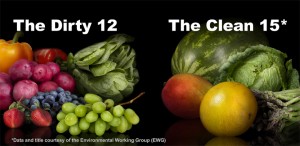Brought to you by Deepak Chopra, M.D., Alexander Tsiaras, and TheVisualMD.com
The benefits of organic farming are undeniable. Crops grown without chemical pesticides do not contaminate the earth with toxic substances. Organic farmers use crop rotation and other natural processes to keep the soil healthy and fertile. Studies show that some (but not all) organically grown fruits and vegetables are higher in certain nutrients than the conventionally grown versions. But organic farming is more expensive than conventional farming, and that fact is reflected in the price of organic foods. As organic farming becomes more common, organic produce will be more widely available and prices should come down.
For now, shop strategically. Some conventionally grown fruits and vegetables retain very low amounts of pesticides by the time they reach the marketplace. The Environmental Working Group (EWG) is an advocacy group that aims to protect public health and the environment. Using government analyses of pesticide levels in foods, the EWG has compiled a list of the fruits and vegetables most and least likely to have pesticide residues: The Dirty Dozen and the Clean 15.
According to EWG, “You can lower your pesticide consumption by nearly four-fifths by avoiding the 12 most contaminated fruits and vegetables and instead eating the least contaminated produce.” Check out the results of their research, below, before your next trip to the market.
The Dirty Dozen
These fruits and vegetables tend to be high in pesticide residue when grown conventionally. Buy them from an organic source whenever you can.
Celery
Peaches
Strawberries
Apples
Blueberries
Nectarines
Sweet bell peppers
Spinach, kale, collard greens
Cherries
Potatoes
Imported grapes
Lettuce
The Clean 15*
When grown conventionally, these items remain low in pesticide residue. There are fewer advantages to buying them from an organic source.
Onions
Avocado
Sweet corn
Pineapple
Mango
Sweet peas
Asparagus
Kiwi fruit
Cabbage
Eggplant
Cantaloupe
Watermelon
Grapefruit
Sweet potato
Sweet onion
*Data and title courtesy of the Environmental Working Group (EWG)
The United States Department of Agriculture (USDA) Pesticide Data Program has analyzed the pesticide levels of domestic food products since it began in 1991. The group tests washed, ready-to-eat produce. Between 1993 and 2003, about 58 percent of the sampled fruits and vegetables were found to contain pesticides, although in greatly varying amounts. There are six produce items in particular that had detectable residues on 90 percent of the samples for two years or more. These are apples, celery, cherries, nectarines, peaches and strawberries. Fewer than 1 percent of the produce sampled contained levels higher than those recommended by the Environmental Protection Agency.
For additional information: USDA Pesticide Data Program: Pesticide Residues on Fresh and Processed Fruit and Vegetables, Grains, Meats, Milk, and Drinking Water.
We have continuing discussions following this article on our Facebook Page.
Learn more about balancing your diet with healthful produce:
TheVisualMD.com: Foods to Enjoy

